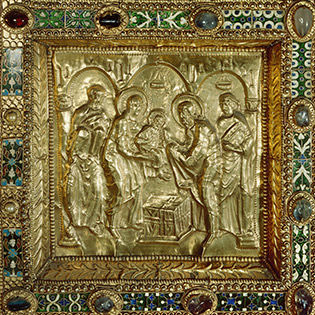Christ on the altar: visualising his sacrifice at the time of Byzantine iconoclasm and other theological controversies
- Dates
- Wednesday 9 October 2019 (14:15-16:00)

Centre for the Study of the Middle Ages Seminar series 2019/20 - Writing and Records
- Speaker: Francesca DELL'ACQUA (Salerno)
We welcome anyone who is at all interested in the research and concerns of the Centre for the Study of the Middle Ages. Each paper will be followed by a pause for refreshments, then questions. After that anyone who wishes will retire for more relaxed conversation, and then we take the speaker out for an early dinner. If you would like to join the speaker for dinner please let the convenor know (Naomi Standen, n.standen@bham.ac.uk) by the end of the Monday before the seminar.
Abstract
In this lecture I will analyse how the official Presentation of the newborn Christ Child to the community of Israelites in the Temple of Jerusalem was relevant to the period coinciding with theological controversies which saw Rome, the North, and Byzantium holding opposing views. Many themes were involved in this Gospel episode: the presentation of the newborn child in the Temple, the purification of the mother from having given birth, the offering brought by the parents in thanksgiving, the prophecy of Simeon and his death after having recognised Christ as the Saviour. As a result, the event became the object of different interpretations, as attested by texts and visual arts, which reflect substantial changes in the religious mentality between the seventh and the ninth centuries.
However, the theme which became focal around the late eighth and the early ninth centuries, was the Presentation of the Child as a prefiguration of his sacrifice on the Cross for the deliverance of humankind. Likely reflecting on-going theological debates on Christ’s real presence on the altar, and on the legitimacy of depicting him, this emphasis produced a new understanding and a new mental vision of the Presentation, which led to an important iconographic innovation. In the early ninth century, in objects related to iconophile circles in West and in the East, the Infant was depicted above an altar while Mary held him with reverence. This imagery was a powerful reminder of the physicality of the Incarnate God: as an infant he was symbolically offered on the altar of the Temple, as an adult his life was sacrificed on the Cross according to his Father’s will for the redemption of mankind. Henceforth the altar became be a central element in the pictorial images of the Presentation, as many late medieval examples attest.
Speaker biography
Francesca Dell’Acqua holds a PhD in History of Art from the Scuola Normale Superiore di Pisa (2001). Since 2005 she has been Assistant Professor of Medieval Art at the University of Salerno, and holds the Italian habilitation to Associate Professorship (ASN 2012). She has been Marie Skłodowska-Curie Research Fellow at the Centre for Byzantine, Ottoman and Modern Greek Studies at the University of Birmingham (2015–2017), and is affiliated to the project ‘Moving Byzantium’ led by Claudia Rapp at the Austrian Academy of Sciences (2017–2020). She is the initiator and co-director of the interdisciplinary project At the Crossroads of Empire: the Longobard Church of Sant'Ambrogio (Montecorvino, Salerno).
She has published in the fields of early medieval western and Byzantine art and cultural history, focusing especially on the relationship between texts, objects, and images. Her book Iconophilia. Religion, Politics, and the Use of Images in Rome c.680–880 (series Birmingham Byzantine and Ottoman Studies, Routledge) is forthcoming, as well as her co-edited book (with E. Mainoldi) Pseudo-Dionysius and Christian Visual Culture c.500–900 (series New Approaches to Byzantine History and Culture, Palgrave).